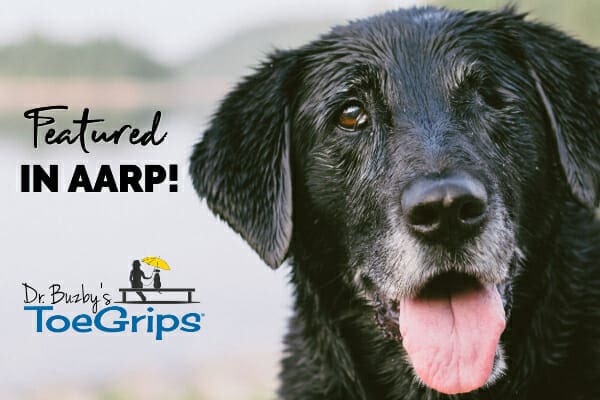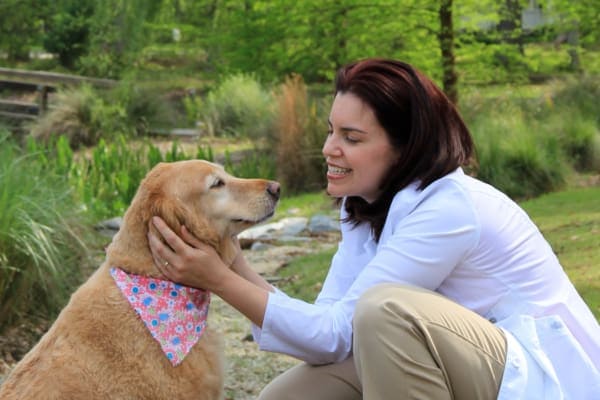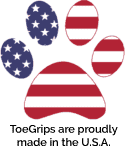Yes, I’m in AARP! Ok. Not me personally, although I’m getting closer to my membership. ? This is even better news:
I’m delighted to share that AARP is shining a spotlight on senior dogs and innovative products designed to help our grey-muzzled companions thrive through their golden years. And ToeGrips® dog nail grips are one of AARP’s featured product recommendations for senior dogs.
It’s an honor to see my signature product which helps senior dogs regain mobility featured in the story. More importantly, it’s my privilege to be able to help geriatric dogs of all ages, shapes, and sizes enjoy more good days.

My interview with AARP: A behind-the-scenes look
AARP’s article is chock-full of great content, which you can read here…
Senior dogs—and products designed to help them maintain grace and dignity as they age—are featured in AARP’s article, New Products Help Old Dogs Age Well.
Yet, as a veterinarian whose mission is to help senior dogs live the happiest lives possible, there is always more to convey! I hope you enjoy this behind-the-scenes peek into some of my favorite topics that I shared with AARP’s top-notch writer, Sara Ventiera.
1. Mobility = Quality of life
Mobility is a senior dog’s greatest asset. Dogs were designed to move. As senior dogs begin to lose their ability to get around, they can become detached from their families—either physically or emotionally—and eventually detached from the doggy pleasures of life.
Keeping dogs on their feet is critical to quality of life in the senior years. As a veterinarian, I try to accomplish that through a number of means:
- Encouraging dog parents to keep their dogs lean and active. (You can start by easily assessing your dog’s canine body condition score.)
- Prescribing anti-inflammatory drugs and/or pain medications—aka “better living through chemistry.”
- Recommending safe, effective supplements such as Green Lipped Mussel and New Zealand Deer Velvet for dogs.
- Applying ToeGrips® dog nail grips for increased traction and confidence. This quote from AARP’s article, best summarizes why ToeGrips improve quality of life for senior dogs by preventing slippage…
2. Don’t forget dogs are not people.
Although one of my favorite bumper stickers reads: Dogs are people too!, dogs are, in fact, not people. Let me explain several ways this is relevant.
First of all, dogs are quadrupeds (standing and walking on four legs) while humans are bipeds (walking on two legs). When we try to liken our dog’s gaiting biomechanics to our own, we’re going to be inherently mistaken and not understand how their bodies function to create movement. Recognizing your dog’s normal baseline gaiting patterns can help you quickly identify lameness and pain when that gait is “off.”
Next, humans wear socks and boots to manuever, but boots and socks actually detract from a dog’s ability to maneuver. Dogs’ paws are filled with receptors that send signals to the brain about proprioception—where their body is oriented spatially with respect to gravity. Instead of enabling a dog’s natural traction mechanism—using the toenails like soccer cleats—boots and socks cover up those receptors and effectively disable natural traction.
Finally, the things that bring your dog joy may be off your radar as a Homo sapien. Remember how very sensitive and powerful a dog’s sense of smell is. Taking a senior dog outside to let them smell the air can be a real treat. Also, if your dog can no longer accompany you on long walks, taking him or her along in a stroller or wagon may provide healthy stimulation without physical exertion.
3. Focus on the “cans” and not the “cannots.”
It seems almost daily I receive messages from pet owners who fear that they are sharing the last days with their pet. As sad as those can be, I find joy in reading messages from the dog parents who tell me they have decided the best course of action is to help their pet live life to the fullest. I applaud that “can-do” attitude and the practical innovations often required to navigate life with a fragile senior dog.
As a dog ages, just like a person, they will begin to lose the ability to do things they could do in their prime. This might range from seeing/chasing squirrels in the yard to easily getting in and out of a vehicle. It’s hard to watch a loved one begin to “fail.”
The antidote is to focus on all the things your dog still enjoys doing and make the most of those experiences. Taking neighborhood walks, sniffing new scents, enjoying belly rubs, plopping down in a new orthopedic bed, munching on high value treats…the list goes on and on. (Plus, it is a very personal one for each dog and family.) Your job is to deliver “can do” opportunities for joy to your dog at every age.

More resources for parents of senior dogs
While my conversation with AARP focused on the three tips above and how ToeGrips dog nail grips can positively impact quality of life, you may be searching for more information on how you can advocate for your senior dog. I’ve made it my mission to share information that can help you help your dog live his best life. Please enjoy these additional resources:
- 6 Crucial Health Habits for Senior Dogs
- When is Your Dog Considered a Senior?
- 8 Ways to Help a Senior Dog With Arthritis
- Should Your Senior Dog See a Dog Chiropractor?
- Senior Dog Anxiety at Night? 6 Solutions for Better Sleep
- Handle with Care: Frailty Syndrome in Senior Dogs

By sharing these resources, my three tips, and AARP’s article, I hope that I’ve inspired and encouraged you as a dog parent. With a healthy dose of knowledge, a strong partnership with your veterinarian, and products designed specifically for senior dogs like ToeGrips, you have the tools in your toolkit to make the senior years golden…for both ends of the leash.

Ready for all the latest good news, helpful tips, and insightful articles about senior dogs?
What tips do you have for helping your senior dog enjoy more good days?
Please comment below. We can all learn from each other.

